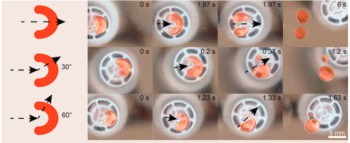
“Marangoni surfers” can manipulate surface tension gradients at fluid interfaces to propel themselves to ultrafast speeds, researchers in Switzerland, Germany and the UK have found. The team, led by Kilian Dietrich at ETH Zurich, demonstrated the effect by illuminating Janus spheres with a special laser, enabling them to reach speeds of up to 10,000 times their length per second.
Active particles are unique in their ability to convert energy from their surrounding environments into straight-line motions – a behaviour made possible through the in-built asymmetry in their shapes or compositions. Owing to their simplicity, particles called Janus spheres are a popular choice for these experiments.
These are silica microbeads with one side left bare, and the other coated in gold. One mechanism that can propel the particles is asymmetric heating of the two surfaces by a light source, with the gold side absorbing more heat than the silica. The resulting temperature gradient surrounding the particle propels the particle in a straight path.
On its own, this mechanism is highly inefficient – only propelling particles to speeds of a few times their body length per second. In their study, Dietrich’s team sought to boost this efficiency by coupling the temperature gradient to surface-tension gradients in the surrounding fluid. They achieved this by positioning Janus spheres at a flat oil-water interface, then illuminating them with a powerful, specially-shaped laser beam.
Surface tension gradients
The resulting temperature asymmetry surrounding the particle lowered the surface tension at the oil-water interface on the warmer gold side, inducing the Marangoni effect – whereby flows arise along surface tension gradients at fluid interfaces. The Janus spheres could then “surf” along the resulting flows, in the direction of the surface tension gradients they created themselves.
In their wake, Dietrich and colleagues found that the Marangoni-surfing spheres left areas in which concentrations of surface tension-reducing surfactant molecules were depleted. This created a second surface tension gradient which acted in the opposite direction to the first – imposing a restriction on their motion. Therefore, the overall velocities of the spheres arose from a balance between these two components.

Janus droplets reflect an explosion of colour
Dietrich’s team could easily control the velocities of their Marangoni surfers by varying either the power of the laser, or the concentration of surfactants at the interface. Their demonstrated velocities spanned four orders of magnitude: from microns, to several centimetres – around 10,000 times a sphere’s body length – per second. This represented a vast increase on the speeds of particles which propel themselves along temperature gradients alone.
The team’s discoveries offer new insights into systems whose dynamics are far from thermal equilibrium. Through further research, they could lead to new ways to manipulate active matter – in which large ensembles of suspended particles borrow energy from their surrounding environments to propel themselves and exert mechanical forces.
The research is described in Physical Review Letters.



